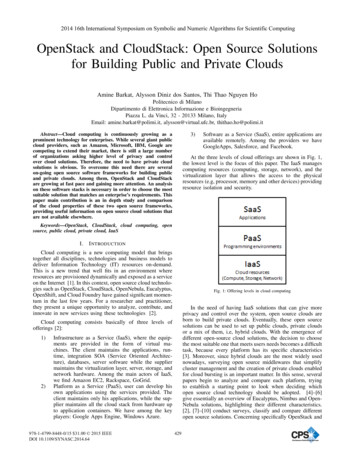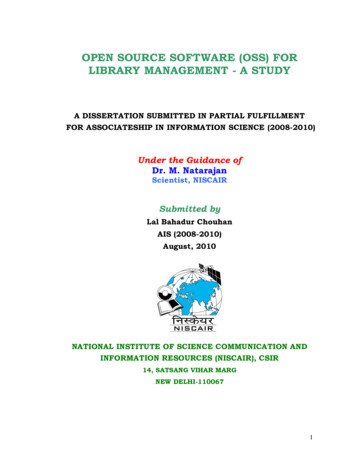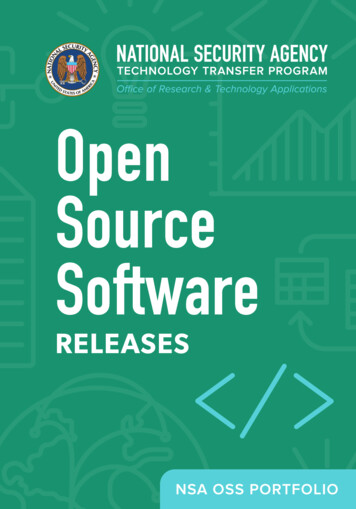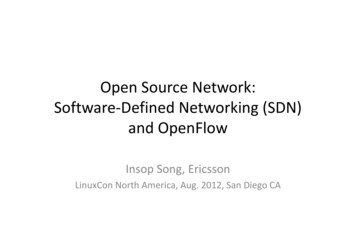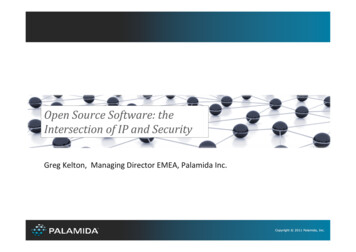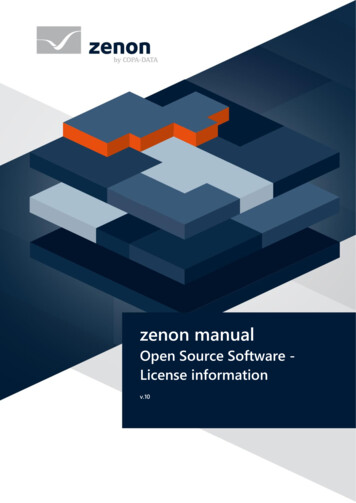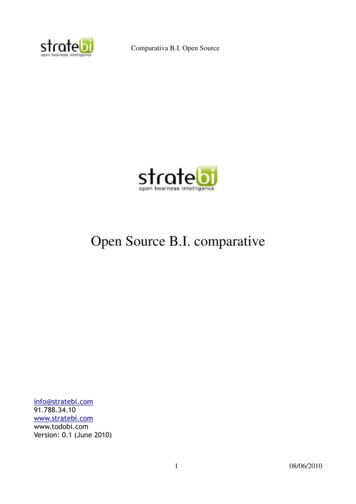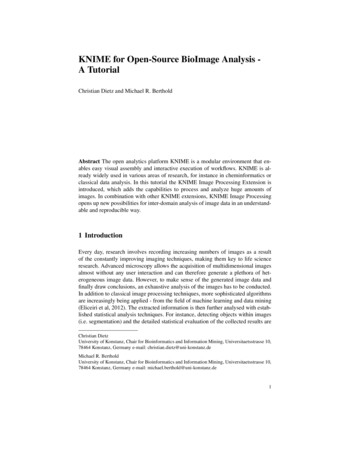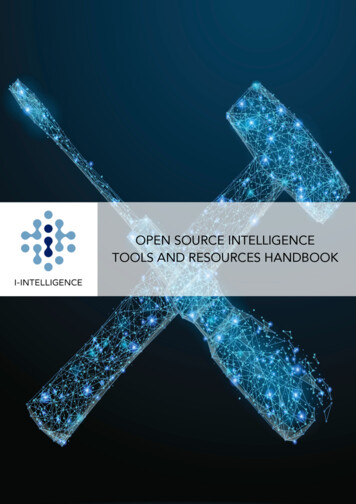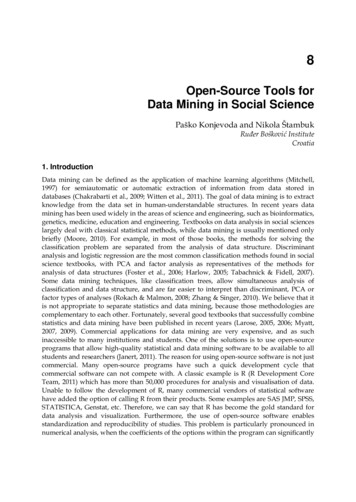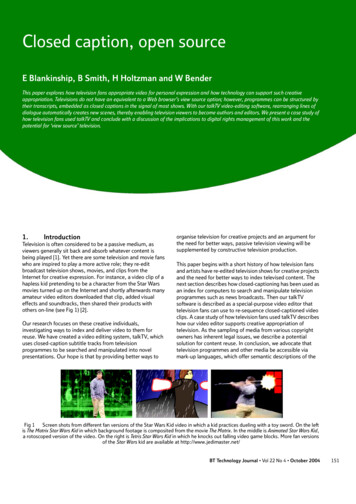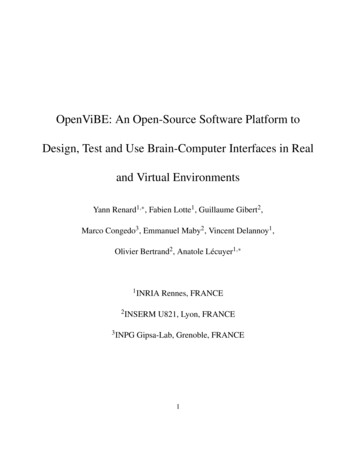
Transcription
OpenViBE: An Open-Source Software Platform toDesign, Test and Use Brain-Computer Interfaces in Realand Virtual EnvironmentsYann Renard1, , Fabien Lotte1 , Guillaume Gibert2 ,Marco Congedo3 , Emmanuel Maby2 , Vincent Delannoy1 ,Olivier Bertrand2 , Anatole Lécuyer1, 1 INRIA2 INSERM3 INPGRennes, FRANCEU821, Lyon, FRANCEGipsa-Lab, Grenoble, FRANCE1
Correspondingauthors:Yann RenardAnatole LécuyerBunraku TeamBunraku TeamINRIA Rennes - Bretagne AtlantiqueINRIA Rennes - Bretagne AtlantiqueCampus universitaire de BeaulieuCampus universitaire de Beaulieu35042 Rennes Cedex35042 Rennes er@irisa.fr2
AbstractThis paper describes the OpenViBE software platform which enables to design, test and useBrain-Computer Interfaces. Brain-Computer Interfaces (BCI) are communication systems thatenable users to send commands to computers only by means of brain activity. BCI are gaininginterest among the Virtual Reality (VR) community since they have appeared as promisinginteraction devices for Virtual Environments (VE). The key features of the platform are 1) a highmodularity, 2) embedded tools for visualization and feedback based on VR and 3D displays, 3)BCI design made available to non-programmers thanks to visual programming and 4) varioustools offered to the different types of users. The platform features are illustrated in this paper withtwo entertaining VR applications based on a BCI. In the first one, users can move a virtual ball byimagining hand movements, while in the second one, they can control a virtual spaceship usingreal or imagined foot movements. Online experiments with these applications together with theevaluation of the platform computational performances showed its suitability for the design of VRapplications controlled with a BCI. OpenViBE is a free software distributed under an open-sourcelicense.3
1 IntroductionOne of the keys to a great immersion feeling with Virtual Reality (VR) is the ease of interactionwith Virtual Environments (VE). Recently, a new method has emerged: interacting throughcerebral activity, using a Brain-Computer Interface (BCI) (Leeb et al., 2007, 2006; Lécuyer et al.,2008). Such an interface is a communication system that enables a user to send commands to acomputer by means of variations of brain activity, which is in turn measured and processed by thesystem (Wolpaw, Birbaumer, McFarland, Pfurtscheller, & Vaughan, 2002). BCI are currentlyfollowing the path drawn by haptic devices a few years ago (Burdea, 1996) by providing acompletely new way of conceiving interaction with computers and electronic devices through the“interaction by thought” concept. The BCI technology is rapidly improving, and severalinteresting applications using BCI have already been developed for navigating or interacting withvirtual environments (Leeb et al., 2007; Lécuyer et al., 2008; Friedman et al., 2007), or forvideogames (Krepki, Blankertz, Curio, & Müller, 2007; Nijholt, 2009).However, designing BCI-based interaction devices requires expertise in a broad range of domains,ranging from neurophysiology, signal processing and interaction, to computer graphics orcomputer programming which represents a challenging multidisciplinary task. A general purposesoftware platform that provides the necessary functionalities to easily design BCI and connectthem with VR would foster the research in the domain and democratize the use of BCI in real andvirtual environments.4
In this paper, we present the OpenViBE platform, a novel, free and open source platform todesign and tune BCI systems and connect them with real and virtual environments. This paper isorganized as follows: section 2 proposes a short state-of-the-art of existing BCI platforms whilesection 3 describes the features of our platform. Section 4 presents the range of users our systemtargets. Sections 5 and 6 detail respectively the design of a BCI with OpenViBE and the tools weprovide. Section 7 is dedicated to the connection with VR and section 8 details the platforminternals. Finally, some examples of BCI implementations, performances and current state of theplatform are presented respectively in sections 9, 10 and 11. The paper ends with a generalconclusion.2 Related work: existing BCI softwareSeveral software for offline and online analysis of EEG and biomedical signals are available.They are briefly reviewed in (Schlögl, Brunner, Scherer, & Glatz, 2007). However, these softwaredo not include all the necessary functionalities for designing a BCI.In the freeware community, only three software enclose the necessary functionalities for real-timeBCI designs: BioSig (Schlögl et al., 2007) (thanks to the “rtsBCI” package), BCI2000 (Mellinger& Schalk, 2007) and BCI (Maggi, Parini, Perego, & Andreoni, 2008).BioSig is an open-source software library for biomedical signal processing and more specifically5
for BCI research (Schlögl et al., 2007). It is a toolbox for Octave and Matlab which offers severaldata management modules, data import and export, artifact processing, quality control, featureextraction algorithms, classification methods, etc. It also offers rapid prototyping of online andreal-time BCI with the “rtsBCI” package using Matlab/Simulink.BCI2000 is a general-purpose system for BCI research (Mellinger & Schalk, 2007). Thissoftware is not open-source but its sources and executables are available for free for non-profitresearch and educational purposes. BCI2000 is a C software that proposes to build an onlineand real-time BCI by assembling four modules: the source module, for data acquisition andstorage ; the signal processing module, that comprises the preprocessing, feature extraction andclassification of brain activity ; the user application module, with which the user interacts ; andfinally, the operator interface for data visualization and system configuration. Interestingly,BCI2000 also provides tools for offline analysis of data within the “MARIO” software.Recently, another BCI software platform has been proposed: BCI (Maggi et al., 2008). Thissoftware is a C/C framework for designing BCI systems and experiments. BCI also includessome 2D/3D features for BCI feedback. However, it should be mentioned that this platform is notcompletely open-source.A comparison of these software with OpenViBE is provided in section 3.1.6
3 OpenViBE featuresOpenViBE is a free and open-source software platform for the design, test and use ofBrain-Computer Interfaces. The platform consists of a set of software modules that can be easilyand efficiently integrated to design BCI for both real and VR applications. Key features of theplatform are:Modularity and reusability. Our platform is a set of software modules devoted to theacquisition, pre-processing, processing and visualization of cerebral data, as well as to theinteraction with VR displays. OpenViBE being a general purpose software implies that users areable to easily add new software modules in order to fit their needs. This is ensured thanks to thebox concept, an elementary component in charge of a fraction of the whole processing pipeline,that allows to develop reusable components, reduces development time and helps to quicklyextend functionalities.Different types of users. OpenViBE is designed for different types of users: VR developers,clinicians, BCI researchers, etc. Their various needs are addressed and different tools areproposed for each of them, depending on their programming skills and their knowledge in brainprocesses.Portability. The platform operates independently from the different software targets andhardware devices. It includes an abstract level of representation allowing to run with variousacquisition machines, such as EEG or MEG. It can run on Windows and Linux operating systems7
and also includes different data visualisation techniques. Finally, it is based on free and portablesoftware (e.g., GTK 1 , IT 2 , GSL3 , VRPN4 , GCC5 ).Connection with VR. Our software can be integrated with high-end VR applications. OpenViBEacts as an external peripheral to any kind of real and virtual environments. It also takes advantageof VR displays thanks to a light abstraction of a scenegraph management library, allowing tovisualize cerebral activity in a legible way or to provide incentive training environments (e.g., forneurofeedback).1 TheGnome ToolKit is a highly usable, feature rich toolkit for creating graphical user interfaces which boastscross platform compatibility and offers an easy to use API. More information can be found at http://www.gtk.org2 IT is a C library of mathematical, signal processing and communication routines. More information can befound at http://sourceforge.net/apps/wordpress/itpp3 TheGNU Scientific Library is a numerical library for C and C programmers. More information can be foundat http://www.gnu.org/software/gsl4 TheVirtual-Reality Peripheral Network is a set of classes within a library designed to implement an interfacebetween application programs and the set of physical devices used in a virtual-reality system. More information canbe found at http://www.cs.unc.edu/Research/vrpn5 TheGNU Compiler Collection is a compiler which supports a wide range of architectures. More informationscan be found at http://gcc.gnu.org8
3.1 Comparison with other BCI platformsIn comparison to other BCI software, the OpenViBE platform appears as highly modular. Itaddresses the needs of different types of users (should they be programmers or non-programmers)and proposes a user-friendly graphical language which allows non-programmers to design a BCIwithout writing a single line of code. In contrast, all other BCI platforms require some degree ofprogramming skills to design a new real-time BCI from scratch. Furthermore, their modularity iscoarser (except for BioSig), hence restricting the range of possible designs.OpenViBE is also portable, independent of the hardware or software and is entirely based on freeand open-source software. In comparison, among other real-time BCI platforms, only BioSig isfully open-source but the “rtsBCI” package needed for online and real-time BCI requiresMatlab/Simulink which a non-free and proprietary software.OpenViBE proposes to generate online scenarios (step 3 in Figure 1) automatically from offlineanalysis (step 2 in Figure 1). Finally, in contrast with other platforms, OpenViBE is well suitedfor VR applications as it provides several embedded tools to design innovative VR displays andfeedback as well as to perform 3D visualization of brain activity in real-time. Furthermore,OpenViBE can also be used as a device for any VR application.9
4 Different types of usersOpenViBE has been designed for four types of users. On the first hand, the developer and theapplication developer are both programmers, on the other hand the author and the operator do notneed any programming skills.The developer (programmer) has the possibility to add new functionalities and test his ownpieces of software in OpenViBE. To that end, OpenViBE is delivered with a complete SoftwareDevelopment Kit (SDK). This SDK provides access to functionalities at different levelsdepending on the task to realize. There are two main categories of developers. First, the kerneldevelopers who enhance and modify kernel functionalities (see section 8.2). Second, plugindevelopers who create new additional modules (see section 8.3).The application developer (programmer) uses the SDK to create standalone applications, usingOpenViBE as a library. Such applications range from new tools such as the visual scenario editordescribed in section 6, to external VR applications that the BCI user can interact with. Such VRapplications are presented in section 7.The author (non-programmer) uses the visual scenario editor (see Figure 2) to arrange existingboxes to form a scenario. He configures these boxes and the scenario in order to produce acomplete, ready-to-use BCI system. The author is aware of the internals of our platform as wellas of BCI systems and is familiar with basic signal processing. He is also aware of the interactionparadigm to use. However, he does not need strong computer programming skills because he uses10
dedicated tools to perform his tasks (see section 6).The operator (non-programmer) generally would be a clinician or a practitioner (he is not acomputer expert nor an OpenViBE expert). He is in charge of using and running the pre-builtscenarios of the author. He then simply runs the scenario. He is aware of how the BCI systemshould and can work, and monitors the execution of the BCI system thanks to dedicatedvisualization components. He has understanding of neurophysiological signals and can help theBCI user to improve his control over the BCI system.Finaly, another role should be considered: the BCI user. The BCI user generally wears the brainactivity acquisition hardware (e.g., an EEG cap) and interacts with an application by means of hismental activity. The application could be for instance, a neurofeedback training program, avideogame in virtual reality, a remote operation in augmented reality, etc. While he does notdirectly use the OpenViBE platform, he implicitly takes advantage of its features.5 How to design a BCI with OpenViBE?Designing and operating an online BCI with our software follows a rather universal way of doingso (Wolpaw et al., 2002). Three distinct steps are required (see Figure 1). In the first step, atraining dataset must be recorded for a given subject, while he performs specific mental tasks.The second step consists in an offline analysis of these records with the goal of finding the best11
calibration parameters (e.g. optimal features, relevant channels, etc.) for this subject. The laststep consists in using the BCI online in a closed loop process. Optionally, iterations can be doneon data acquisition and offline training in order to refine the parameters.The online loop (third step) is common to any BCI and it is composed of six phases: brain activitymeasurements, preprocessing, feature extraction, classification, translation into a command andfeedback (see Figure 1).Figure 1 here.Brain activity measurements: This step consists in measuring the brain activity of the BCI user.To date, about half a dozen different kinds of brain signals have been identified as suitable for aBCI, i.e., easily observable and controllable (Wolpaw et al., 2002). Measuring the brain activityfor a BCI system is mainly performed using electroencephalography (EEG) since it is acost-effective and non-invasive method which provides a high temporal resolution (Wolpaw et al.,2002). Our software already supports various EEG acquisition devices but also supports amagnetoencephalography (MEG) machine (see Section 11 for a list of supported devices).Preprocessing: The preprocessing step aims at denoising the acquired signals and/or atenhancing a specific brain signal (Bashashati, Fatourechi, Ward, & Birch, 2007). For example,our software proposes different kinds of preprocessing algorithms such as temporal filters and12
spatial filters (independent component analysis, surface Laplacian, etc.).Feature Extraction: Once signals have been preprocessed, features can be extracted. Thesefeatures consist in a few values that describe the relevant information embedded in the signals(Bashashati et al., 2007) such as the power of the signals in specific frequency bands(Pfurtscheller & Neuper, 2001). These features are then gathered into a vector called “featurevector”. Examples of features available in OpenViBE include band power features or powerspectral densities.Classification: The feature vector is fed into an algorithm known as “classifier”. A classifierassigns a class to each feature vector, this class being an identifier of the brain signal that has beenrecognized. In general, the classifier is trained beforehand using a set of feature vectors from eachclass. An example of classifier used for BCI would be the Linear Discriminant Analysis (Lotte,Congedo, Lécuyer, Lamarche, & Arnaldi, 2007). It should be noted that, due to the highvariability and noisiness of EEG signals, classification rates of 100 % are very rarely attained,even for a BCI using two mental states. OpenViBE proposes several classifiers such as LinearDiscriminant Analysis (Lotte, Congedo, et al., 2007) or Fuzzy Inference Systems (Lotte, Lécuyer,Lamarche, & Arnaldi, 2007).Translation into a command: Once the class of the signal has been identified, it can beassociated to a command which is sent to a computer in order to control, for instance, a robot(Millán, 2008) or a prosthesis (Wolpaw et al., 2002). The number of possible commands in13
current EEG-based BCI systems typically varies between 1 and 4.Feedback: Finally, feedback should be provided to the user so that he can determine whether hecorrectly performed the brain signal. This is an important step as it helps the user to control hisbrain activity (Lotte, Renard, & Lécuyer, 2008; Neuper, Scherer, Wriessnegger, & Pfurtscheller,2009). Feedback can be simple visual or audio cues, e.g., gauges. To this aim, our softwareproposes classical raw signal, spectra, time/frequency visualisation modules. Alternatively, moreadvanced feedback can be provided such as the modification of a virtual environment (Leeb et al.,2007) to which OpenViBE send commands.6 ToolsOur system includes a number of usefull tools for its various users: the acquisition server, thedesigner, 2D visualization tools and sample scenarios of BCI or neurofeedback.The acquisition server provides a generic interface to various kinds of acquisition machines,e.g., EEG or MEG systems. Such an abstraction allows the author to create hardware independentscenarios, thanks to the use of a generic acquisition box. This box receives the data via thenetwork from the acquisition server, which is actually connected to the hardware and transformsthese data in a generic way. The way the acquisition server gets connected to the device mostlydepends on the hardware manufacturer’s way to access his device. Some devices will be shipped14
with a specific Software Development Kit, some others will propose a communication protocolover a network/serial/USB connection. Finally, some devices will need a proprietary acquisitionsoftware that delivers the measures to our own acquisition server.The designer is mainly dedicated to the author and enables him to build complete scenariosbased on existing software modules using a dedicated graphical language and a simple GraphicalUser Interface (GUI) as shown in Figure 2. The author has access to a list of existing modules in apanel, and can drag and drop them in the scenario window. Each module appears as a rectangularbox with inputs (on top) and outputs (at the bottom). Double clicking on a box displays itsconfiguration panel. Boxes are manually connectable through their inputs and outputs. Thedesigner also allows the author to configure the arrangement of visualization windows (i.e.,visualization modules included in the scenario). An embedded player engine allows the author totest and debug his scenario in real time. In doing so, the author can receive a continuous feedbackon boxes status and their processing times. Such a feedback may be useful to balance thecomputational load.Figure 2 here.The 2D visualization features of the platform are available as specific boxes and include brainactivity related visualizations. These boxes can access all the platform functionalities, and15
particularly the whole stream content for the connected inputs. Most 2D visualization boxesdisplay input data in a widget and do not produce output. Our system offers a wide range ofvisualization paradigms such as raw signal display, gauges, power spectrum, time-frequency mapand 2D topography in which EEG activity is projected on the scalp surface in two dimensions(see figure 3). OpenViBE also provides a visual
3.1 Comparison with other BCI platforms In comparison to other BCI software, the OpenViBE platform appears as highly modular. It addresses the needs of different types of users (should they be programmers or non-programmers) and proposes a user-friendly graphi

